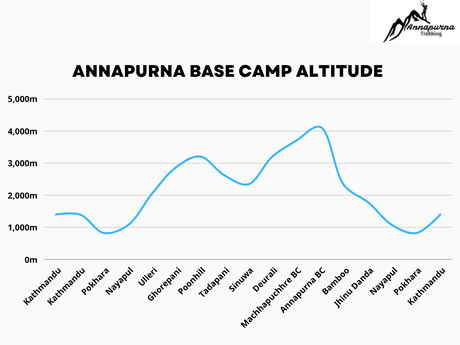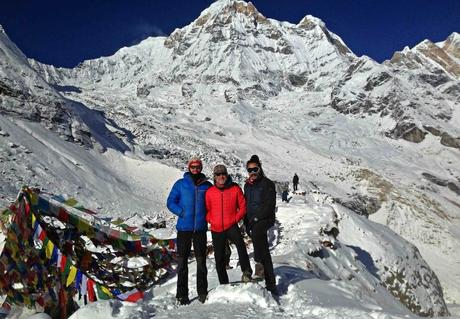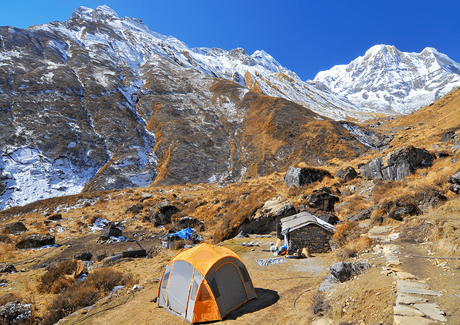Annapurna Base Camp Trek offers a unique experience of exploring the majestic mountain of Annapurna, the 10th highest peak in the world at 8,091 m / 26,545 ft. in the Gandaki province of North West Nepal. This short trek of 7-8 days takes you through picturesque bamboo and rhododendron forests, fascinating Nepali villages, and spectacular vistas.
It is a very famous trek of Nepal around the world. This trek gives exposure to unique Gurung and Magar communities’ traditional practices, cultures, and lifestyle in general. The trail leading to the Annapurna /base camp is filled with unique floras and faunas like pine, fir, rhododendron, oak Langur monkey, snow leopard, red Panda, Musk deer, etc. It is decorated with beautiful monasteries and gompas. The maximum elevation that one walks up to during the Annapurna Base camp trek is 4,130m/13,549ft. So, be careful with the altitude sickness there!
Let us give you a brief on how the elevation changes throughout the trek following the classic trail of the trek.
Elevation of Annapurna Base Camp

The trek to Annapurna Base Camp starts from the capital of Nepal, Kathmandu, which is located at an elevation of 1400 m / 4600 ft above sea level. From there, the journey continues to Pokhara, the city of lakes, which stands at an altitude of 822 m / 2697 ft.
Next, the trail leads to Nayapul, located at 1071 m / 3514 ft. Then, the trek moves on to Hile at an altitude of 1948 m / 6391 ft, followed by a stop at Ghorepani at 2874 m / 9429 ft. Finally, the trek arrives at Poon Hill, located at a stunning 3200 m / 10498 ft.
From Poon Hill, the trek’s altitude decreases until Dovan. First, as you move to Tadapani from Poon Hill, the elevation here falls down to 2630 m / 8628.609 ft then extends to Chhomrong 2178m / 7164 ft. Leaving Chommrong and moving to Dovan the altitude becomes 2600 m / 8530 ft. Be ready for altitude gain now on leaving Dovan and trekking to Deurali. Deurali is situated high up at an altitude of 3200 m / 10498 ft. After Deurali the next place is the Annapurna Base camp itself which is situated at an altitude of 4,130m/13,549ft. On trekking from Deurali to the Annapurna Base camp the toral altitude gain is 930 m / 3051 ft.
It is important to know that as we cross the altitude of 2500 m / 8202 ft our body starts experiencing difficulties in adjusting to the changes. This leads to different sorts of altitude sickness.
ABC Elevation Table
Kathmandu1,400 metres (4,600 ft)
Pokhara895 meters (2,936 ft)
Nayapul1,070 meters (3,510 ft)
Ulleri2,055 meters (6,742 ft)
Tadapani2,630 meters (8,638 ft)
Sinuwa2,340 meters (7,677 ft)
Deurali3,200 meters (10,498 ft)
Machhapuchhre Base Camp3,700 meters (12,139.11 ft)
Annapurna Base camp4,130 meters (13549.87 ft)
Annapurna Base Camp Elevation ProfileFactors that affect elevation gain
- Altitude Acclimatization: One of the most important factors to consider while trekking in high-altitude regions is acclimatization. The rate at which you gain elevation plays a crucial role in allowing your body to adjust to the thinning air and decreasing oxygen levels. It is recommended to ascend gradually, giving your body enough time to adapt to the changing altitude. This is why the Annapurna Base Camp trek follows a well-planned itinerary with gradual altitude gain and rest days at certain points.
- Physical Fitness: Your physical fitness level is another crucial factor that affects your ability to handle the elevation gain during the trek. The Annapurna Base Camp trail involves steep ascents and descents, and walking at higher altitudes can be physically demanding. Good cardiovascular fitness, endurance, and strength will help you cope with the challenges posed by the trek.
- Hydration and Nutrition: Proper hydration and nutrition are vital during high-altitude treks. Dehydration can worsen the symptoms of altitude sickness, so it is important to drink plenty of fluids, especially water. Maintaining a balanced diet and consuming enough calories will provide your body with the energy it needs for the trek and help in altitude adaptation.
- Weather and Season: Weather conditions and the time of year you undertake the trek can impact the elevation gain. In Nepal, the Annapurna Base Camp trek is popularly done during the spring (March to May) and autumn (September to November) seasons when the weather is generally stable and favorable for trekking. However, it is important to be prepared for changes in weather, such as sudden temperature drops or heavy snowfall at higher altitudes, which can affect the trekking conditions and elevation gain.
- Trekking Pace: The pace at which you trek also affects the elevation gain. It is recommended to maintain a steady and moderate pace to conserve energy and avoid overexertion. Going too fast can lead to fatigue and altitude sickness, while going too slow may prolong the time spent at higher altitudes, increasing the risk of altitude-related issues.
- Personal Health Conditions: Individual health conditions and medical history can influence how well you adapt to higher altitudes. Certain medical conditions, such as respiratory problems, heart conditions, or a history of altitude sickness, may require special precautions or consultation with a healthcare professional before attempting the trek.
It is essential to be aware of these factors and prepare accordingly to ensure a safe and enjoyable trekking experience in the Annapurna Base Camp region.
Also Read: Annapurna Base Camp Trek Cost 2023

What is altitude sickness?
Altitude sickness is basically an uneasiness our body experiences as the elevation increases. It is characterized by feeling lightheaded, nausea, dizziness, shortness of breath, vomiting, etc. Another popular term used in place of altitude sickness is acute mountain sickness. With the increase in elevation, altitude sickness gets worse and our bodies may even suffer fatally. This happens due to thinning of the air and a decrease in air pressure. Since we are not generally used to surrounding ourselves with much less air pressure and high elevation it leads to acute mountain sickness.
There are three known acute altitude sicknesses based on severity, they are:
- Acute mountain sickness
Acute sickness is experienced by almost everyone once on the trek. This is the most familiar one out of all the mountain sicknesses. It is not severe or fatal. If you suffer from it, your body gets fatigued, gets a headache, feels nauseous, suffers from insomnia, and loses your appetite. The most common symptom of acute mountain sickness is that you won’t feel stable in your feet and body and feel really lightheaded.
- High Altitude Pulmonary Edema
High-altitude Pulmonary edema is quite dangerous. The typical reason for HAPE is a decrease in oxygen as the altitude increases. What happens when a person suffers from High altitude Pulmonary edema is: the capillaries present in the lungs leak and start acquiring fluid in the lungs. Since, your lung function is now interrupted you are going to find it hard to breathe, feel exhausted, feel out of breath, cough, the gradual and noticeable increase in heart rate, your lips and nails get blue, and so on.
- HACE (High Altitude Cerebral Edema )
It is a more dangerous form of altitude sickness. The lowest altitude that has ever been recorded to cause High Altitude Cerebral Edema is 2590 m / 8497.375 ft. However, the altitude generally expected to cause HACe is 3600+ m / 11811 ft. This is the most dangerous altitude sickness. It can be life-threatening if not treated in time. It can be experienced with High altitude cerebral edema sometimes. Like HACE, HAPE is life-threatening too.
The reason why this is so dangerous is: fluid starts forming in our brain eventually making it swell. Other lesser severe symptoms of High Altitude Cerebral Edema are: feeling really lethargic, weariness, unable to walk sternly, severe headache, nausea, blurred vision, etc.

Reasons for Acute Mountain Sickness
The most common causes of Acute Mountain Sickness are:
- Lower air pressure than our body is used to
- Lack of oxygen
- Change in altitude from low to high
- The disability of our bodies to adapt to the changed environmental conditions
Reasons for High Altitude pulmonary edema and High Altitude Cerebral Edema
Some of the reasons that cause HAPE and HACE are;
- The main reason for HAPE and HACE is the lack of oxygen, commonly termed “hypoxia”.
- Rapid gain in height.
- Trying to cover long distances while ascending in one go.
How to prevent Acute mountain sickness.
Prevention is indeed better than cure. So, what do you need to stay safe and far far away from Acute Mountain sickness? Read the points below thoroughly.
Acclimatization!!! We can not gush enough about how important acclimatization is. What is acclimatization you may ask? Acclimatization is the process of getting our body slowly adapt to the changed surrounding. The perfect way to acclimatize is to spare a day before moving to a really high altitude and attempt small hikes to nearby areas. These small hikes should be just enough to keep you physically active but not to the point where you feel exhausted because the energy in our bodies must be saved.
Do not attempt to gain more than 300 m / 10137 ft to 500 m / 1640 ft of altitude in a day. Doing so ensures our body does not experience a severe decrement in air pressure at once. This lets our body adjust well to altitude gain.
Eat high-calorie and healthy food. By healthy we mean avoiding eating greasy and spicy food.
Never ever smoke or drink on your trekking days. This harms our lungs and will cause shortness of breath which is not good because our body is already at an altitude where there is a lesser oxygen level. Drinking and Smoking during the trek harm your body more than you anticipate.
In case the body starts experiencing mild symptoms of acute mountain sickness do not trek further ahead. Stop and rest where ever you are.
Make sure to stay hydrated. This helps the body feel fresh and light which means easy trekking!
Following these safety measures one can easily tackle acute mountain sickness during the Annapurna Base camp trek as well as any other higher-altitude trek. But even after being very cautious, there is no guarantee that you are not going to be a victim of mountain sickness at all. So what do you do if you or somebody trekking with you suffers from altitude sickness? Annapurna Base Camp trek has an altitude that is known to cause acute mountain sickness so in case you do experience altitude sickness while on Annapurna Base Camp terk or any other trek here’s what to do:
- The first thing to do as a first aid treatment is to stop trekking and rest, keep yourself warm, eat warm foods, and get hydrated.
- Take the most commonly prescribed medicines like paracetamol and ibuprofen to stop headaches, and promethazine to treat nausea.
- For HAPE and HACE do not forget dexamethasone. This medicine decreases swelling, gets your body temperature to normal, and makes breathing easier
- If the altitude sickness does not seem to get under control with these first aid treatments then get down to a lower elevation and seek professional help.
- Another important thing is, do not ever proceed trekking further if you feel a little better after first aid treatment. Get at least 3 to 4 days of rest.
- Carry oxygen supplements with you. If you feel difficulty in breathing or you feel a shortage of oxygen this oxygen supplement will come in handy.
Once you are done resting, do not feel uneasy and you are 100% sure that there are not any signs and symptoms and signs of acute mountain sickness, go ahead and enjoy your trek following all the safety measures needed and make the most of your trek.
